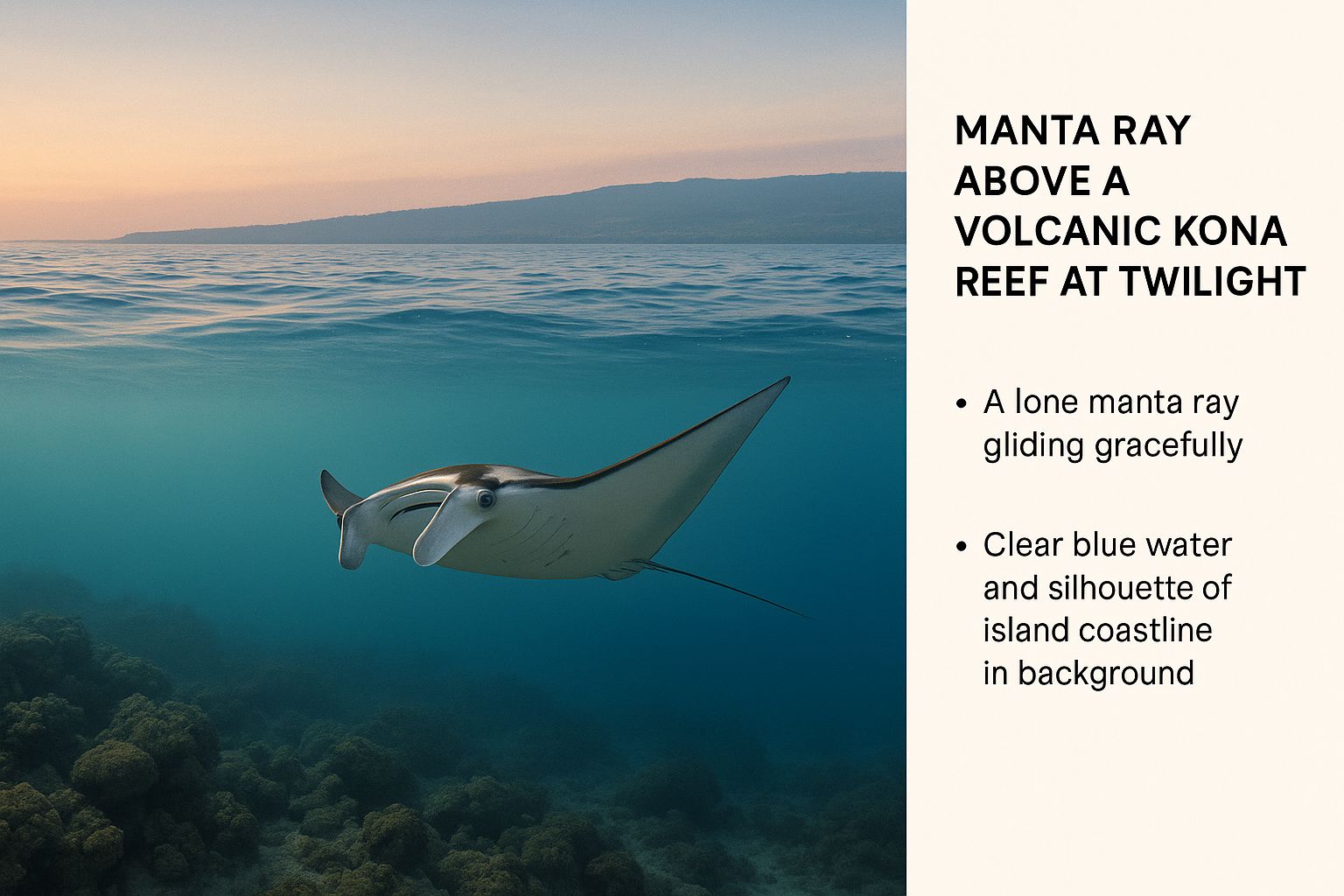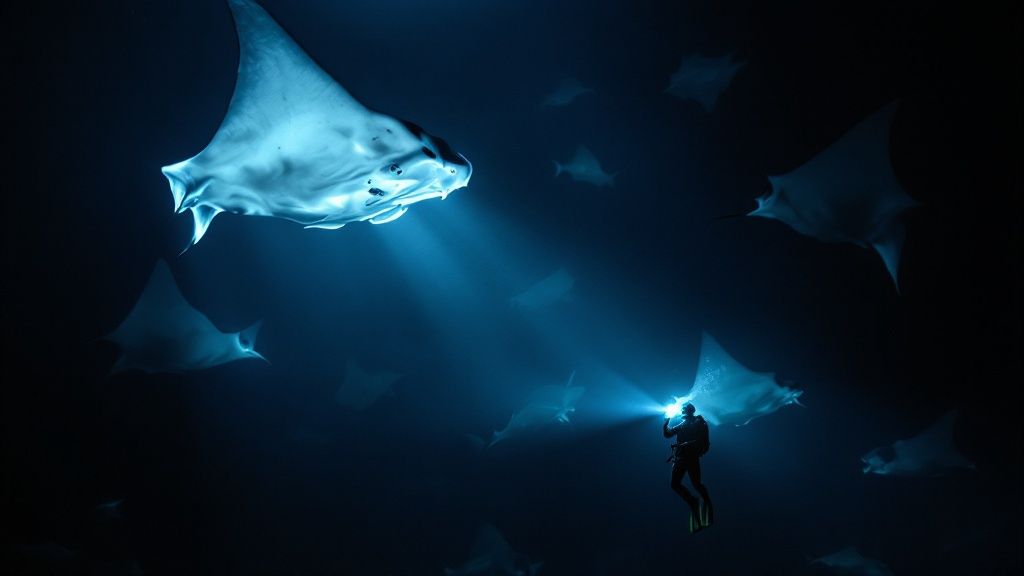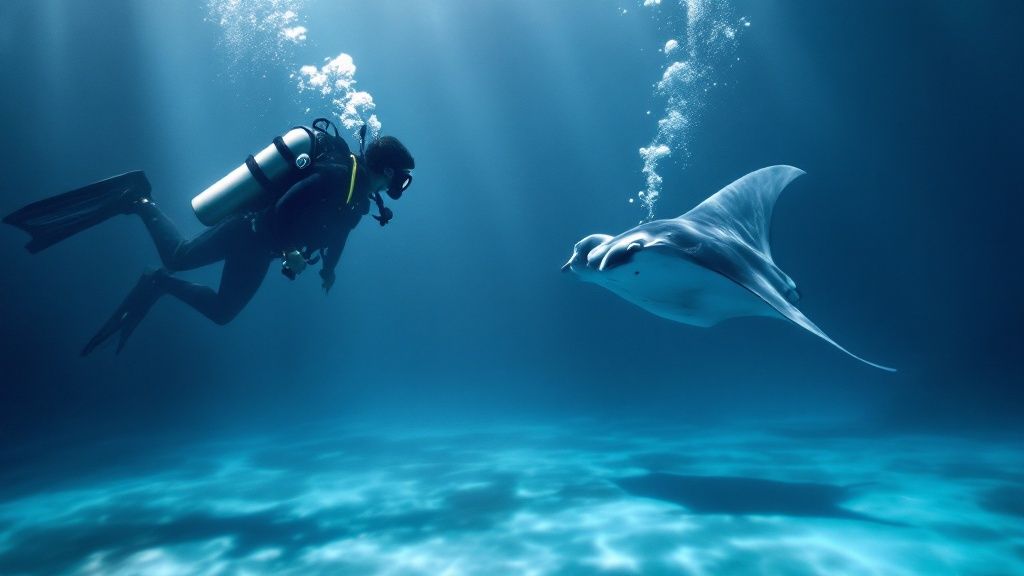Why Kona's Manta Dives Stand Apart From Global Offerings
Manta ray encounters are bucket-list experiences for divers worldwide. However, Kona, Hawaii, offers something truly exceptional. A unique combination of factors makes Kona a premier destination for observing these gentle giants, setting it apart from other manta ray viewing locations.
The Kona Ecosystem: A Perfect Manta Buffet
The foundation of Kona's thriving manta ray population lies in its nutrient-rich waters. Consistent plankton blooms, fueled by these nutrients, create a reliable food source, drawing mantas to predictable feeding grounds. These shallow, clear waters, typically 30-40 feet deep, provide exceptional visibility for divers and snorkelers. Sheltered coves add an extra layer of calm, creating an ideal environment for both the mantas and those who come to admire them.
Respectful Dive Practices: A Tradition of Care
In Hawaii, mantas are held in high cultural regard. This respect is reflected in the dive practices, often developed in consultation with marine biologists. These protocols prioritize the well-being of the manta rays and ensure a sustainable experience for visitors. This conscious approach fosters a sense of responsibility and connection with the marine environment, distinguishing Kona's manta dives. Curious about what a manta ray night dive entails? Learn more here.
Scientific Significance: A Hub for Discovery
Kona isn't just a tourist destination; it's a living laboratory for manta ray research. The predictable presence of the manta population makes it a prime location for scientific study. Researchers leverage this unique setting to study manta behavior, social structures, and reproductive patterns. This research contributes significantly to our global understanding of these magnificent creatures and informs conservation efforts worldwide.
Unparalleled Sighting Rates: A Kona Guarantee
Manta ray night dives in Kona boast remarkably high sighting rates. Local dive operators, like Jack's Diving Locker, report encounters in 85-90% of dives. With an average wingspan exceeding 12 feet, these majestic creatures offer an awe-inspiring spectacle. Dives typically last 45 to 60 minutes, providing ample time for observation and photography. Kona's local manta population is estimated at over 450 individuals, pushing sighting probabilities even higher, often exceeding 95% on some nights. Detailed statistics are available here.
Why Choose Kona? The Ultimate Manta Experience
What truly sets Kona apart? The unique blend of reliable sightings, respectful practices, and scientific significance creates an unmatched experience. It's a place where education, conservation, and breathtaking encounters converge, ensuring a memorable experience for divers of all skill levels. Read more about mastering the manta ray dive. This holistic approach also contributes to the long-term health and protection of the manta ray population.
Crafting Your Ultimate Manta Dive Kona Experience
Transform your Hawaii trip into an unforgettable adventure by optimizing your manta ray encounter. This guide offers insider tips, from the initial planning stages to the dive itself, ensuring you maximize your manta magic.
Planning Your Dive: Timing and Operators
Planning is key to a successful manta dive Kona experience. Seasonal variations influence manta ray behavior. Warmer months often bring calmer waters and increased plankton blooms, attracting more mantas.
Moon phases also play a role, influencing ambient light and affecting plankton visibility and manta feeding patterns. Research indicates that moonless nights, when plankton is more easily visible under dive lights, often result in heightened manta activity. Strategically choosing your dive date around the lunar cycle can significantly improve your viewing chances.
Choosing a responsible operator is crucial for a positive impact. Look for operators committed to sustainable practices, such as using eco-friendly lights and adhering to wildlife interaction guidelines. These practices protect the manta ray population and enhance your overall experience.
Choosing Your Adventure: Snorkeling vs. Diving

This image captures the serene beauty of a manta ray gliding over a Kona reef at twilight. It showcases the clear waters and volcanic landscape unique to this location. The infographic highlights the peaceful coexistence of these creatures within their natural habitat, a key aspect of the manta dive Kona experience. The scene emphasizes the wonder and tranquility awaiting divers and snorkelers.
Both snorkeling and diving offer unique manta ray encounters. Snorkelers observe the mantas from the surface, often holding onto a lit float. Divers settle on the ocean floor to watch the graceful ballet from below.
The best choice depends on your comfort level and certification. If you're not a certified diver, snorkeling is a great alternative, offering incredible views of the mantas as they feed. Scuba diving, however, allows for closer proximity and a different perspective of these gentle giants as they glide overhead.
To help you decide which option is best for you, take a look at the comparison table below:
To help you decide which option best suits your needs, we've compiled a comparison table:
Manta Dive Kona: Options Comparison
| Experience Type | Price Range | Experience Required | Average Group Size | Proximity to Mantas | Best For |
|---|---|---|---|---|---|
| Snorkeling | $100-$150 | None | 10-20 | Surface View | Families, Non-certified divers |
| Diving | $150-$250 | Open Water Certification | 4-8 | Closer Proximity | Experienced divers, underwater photographers |
This table summarizes the key differences between snorkeling and diving with manta rays in Kona. Snorkeling is generally more affordable and accessible, while diving provides a closer encounter for certified divers.
Essential Gear and Preparations
Equipment choices significantly impact your experience. A properly fitting wetsuit, even in warm Hawaiian waters, is essential for night dives, as temperatures can drop after sunset. Anti-fog solution for your mask is a must to prevent blurry vision during crucial manta moments.
For less experienced swimmers, a pool noodle can provide additional buoyancy and comfort. Beyond the physical gear, mental preparation is also key. Visualizing the dive, focusing on the beauty of the manta rays, and practicing deep breathing exercises can help reduce anxiety, particularly for those apprehensive about nighttime ocean conditions. Learn more about preparing for ocean dives.
By considering these factors, you can create a truly memorable manta dive Kona experience.
The Fascinating Science Behind Kona's Manta Population
The manta ray night dive in Kona isn't just a thrilling tourist activity; it's a window into the fascinating world of these gentle giants. Kona has become a hub for manta ray research, blending citizen science with marine biology to unlock the secrets of these enigmatic creatures.
Unique Identification: Nature's Fingerprints
Each manta ray boasts a unique belly pattern, similar to a human fingerprint. This natural identification system allows researchers to track individuals over decades, building comprehensive life histories for each animal. This long-term data is essential for understanding population dynamics and shaping effective conservation efforts. The knowledge gained contributes to wider research initiatives, shedding light on manta ray behavior and their role in the ecosystem.
Non-Invasive Research: Technology and Tourism
Modern technologies play a vital role in expanding our knowledge of manta rays. Researchers use these tools to map manta movements, social interactions, and reproductive behaviors, all without disturbing the animals. This non-invasive approach respects the mantas while still providing invaluable data. You might be interested in: Why you should go on a manta ray dive in Kona.
The popularity of manta ray dives has also unexpectedly advanced our understanding of these creatures. The Kona Coast in Hawaii is world-renowned for its manta ray night dives, a phenomenon meticulously documented from 2009 to 2014. Detailed records tracked individual mantas, their locations, and monthly sighting frequency. This revealed behavioral patterns, such as their movement within their home ranges. The data even enabled researchers to predict months with increased manta ray sightings—valuable information for dive operators and ecotourists. The consistency of these sightings makes Kona a unique location where divers can regularly interact with these majestic animals. Find more detailed statistics here.
Citizen Science: Your Dive, Their Data
Your dive photos can directly contribute to ongoing research. By submitting your images to research organizations, you become a citizen scientist, aiding in the tracking of manta ray populations and movements. This collaborative approach enhances data collection and fosters a global community of manta ray advocates dedicated to their protection.

This stunning image captures the beauty and mystery that draw researchers and divers to these gentle giants. The close encounters and clear visibility of the Kona manta ray dive offer exceptional opportunities for both scientific observation and personal connection with these incredible creatures. The image perfectly illustrates the unique environment that supports both the manta ray population and the vital research efforts dedicated to their understanding and preservation.
The Magical Manta Ray Night Dive: A Moment-by-Moment Journey
The manta ray night dive in Kona isn't just a dive; it's an experience. It's a carefully orchestrated ballet of nature, a captivating spectacle that unfolds beneath the waves. From the setting sun to the final ascent, every moment is filled with a sense of wonder and anticipation.
Departure and Arrival: Setting the Scene
As the sun dips below the horizon, casting a warm glow across the Kona sky, your adventure begins. The boat sets off, leaving the familiar coastline behind as you venture towards the designated manta viewing area. The air buzzes with excitement as the dive leader preps you on safety procedures and sets the scene for the underwater encounter that awaits. The journey itself, with the dramatic backdrop of Kona's volcanic slopes, serves as a memorable prelude.
The Underwater Ballet Begins: Lights, Plankton, and Gentle Giants
Upon arrival, divers slip into the cool, dark water. Dive lights cut through the inky blackness, serving a crucial role in attracting plankton—the main food source for the manta rays. Soon, massive shadows begin to take shape in the depths below. Manta rays, with wingspans often exceeding 12 feet, glide gracefully into view. Their movements are both powerful and elegant, a mesmerizing display of aquatic grace. The scene transforms into an ethereal dance of light, plankton, and these gentle giants.
Manta Ray Behaviors: Decoding the Dance
The mantas' feeding behavior is a spectacle in itself. Barrel rolls, graceful underwater somersaults, are a common sight. Sometimes, multiple mantas line up to engage in chain feeding, creating a living filter as they devour plankton. Experienced dive leaders offer insights into these fascinating behaviors, explaining the triggers and guiding you on how to best position yourself for optimal viewing without disturbing the mantas' natural rhythm. Learn more in our article about Manta Ray Night Dive In The Big Island.
Underwater Etiquette: Respecting the Ocean's Gentle Giants
Respecting the delicate balance of this ecosystem is paramount. Maintaining a respectful distance and avoiding contact is crucial. Touching a manta ray can disrupt their protective mucous layer, making them susceptible to infection. Responsible operators stress the importance of passive observation, allowing divers to witness these magnificent creatures in their natural habitat without causing harm.
To help you identify these amazing creatures, we've compiled a handy guide:
Manta Ray Identification Guide
Key characteristics to identify individual manta rays during your Kona dive
| Manta Name | Distinguishing Marks | Typical Size | Frequency of Sightings | Interesting Facts |
|---|---|---|---|---|
| Lefty | Distinct scar on left wing | 14 ft | Common | Often seen barrel rolling |
| Patches | Large white patches on back | 12 ft | Occasional | Prefers to feed near the surface |
| Shadow | Mostly black underside | 16 ft | Rare | The largest manta in the area |
| Freckles | Numerous small spots on belly | 10 ft | Frequent | Often seen with other mantas |
| Scarface | Distinctive scar near mouth | 11 ft | Occasional | Known for its playful behavior |
This table highlights some of the resident manta rays you might encounter during your dive. Each individual has unique markings and behaviors, making every encounter special.
Creating Lasting Memories: A Night to Remember
As the dive comes to an end, the memory of these gentle giants gracefully dancing in the dark will stay with you long after you resurface. The experience transcends a simple dive, becoming a powerful reminder of the beauty and wonder of the ocean. It’s a night to remember, a story you’ll share for years to come.
How Manta Dives Transform Kona's Economy and Ecosystem
The mesmerizing dance of manta rays in Kona's waters isn't just a beautiful natural phenomenon; it's a testament to the interconnected relationship between the economy and the ecosystem. Manta dive tourism has become a cornerstone of Kona's identity, fostering economic prosperity while simultaneously championing conservation initiatives.
Economic Ripple Effects: From Dive Operators to Local Businesses
The popularity of manta ray dives in Kona has given rise to a flourishing industry, bolstering numerous businesses. Dive operators, boat captains, and equipment rental shops directly profit from the influx of tourists eager to witness these graceful giants.
Hotels, restaurants, and other local businesses also see increased revenue as visitors extend their stays and venture out to discover the island. This ripple effect vividly illustrates how ecotourism can uplift communities while advocating for environmental responsibility. Embarking on a Manta Night Dive is a truly unique experience. For a closer look at these dives, check out this article: Kona Manta Ray Night Snorkel
Sustainable Livelihoods: Incentivizing Conservation
Responsible manta tourism provides sustainable incomes for local communities. By creating economic opportunities linked to the well-being of manta rays, it encourages conservation over exploitation.
This model empowers local residents to become protectors of the marine environment, recognizing that the health of the manta ray population directly influences their own livelihoods.
Approximately 80,000 people annually participate in snorkel and dive tours to observe manta rays in Hawaiian waters, with Kona serving as the primary hub. This remarkable tourism activity underscores the global appeal of Kona's manta ray night dives and highlights their economic and ecological significance. This influx of visitors has resulted in the development of organized nightly tours, specifically designed for those hoping to witness the underwater spectacle of these gentle giants. Find more detailed statistics here.
Maintaining the Balance: Protecting Kona's Underwater Treasures
Managing the increasing popularity of manta dives presents distinct challenges. Capacity restrictions on tour boats help prevent overcrowding and minimize disruption to the manta rays' natural environment.
Educational initiatives are vital for promoting respect for the marine environment. These initiatives teach visitors about responsible viewing practices and the importance of conservation. You may also be interested in: Read also: Manta Ray Dive Kona: Your Underwater Nightclub
Emerging Challenges: Navigating a Changing Environment
Despite these successes, new threats are constantly emerging. Light pollution from coastal development can disrupt the plankton blooms that draw the mantas in. Coastal development itself encroaches upon their habitat.
Climate change impacts ocean temperatures and currents, which can potentially affect their feeding patterns. Addressing these complex issues requires ongoing research, flexible management strategies, and continued partnership between scientists, local communities, and tour operators.
Innovative Solutions: Ensuring a Future for Manta Rays and Local Communities
Kona is a leader in developing innovative solutions. Researchers are actively investigating ways to lessen the effects of light pollution, while community-led conservation projects are striving to protect essential habitats.
By proactively confronting these challenges, Kona is committed to ensuring that both manta rays and the local economy continue to flourish together for generations to come.

Extending Your Manta Dive Kona Into a Complete Experience
A manta dive in Kona is more than just a single night dive; it's a chance to connect with these incredible creatures and the vibrant Hawaiian marine ecosystem they call home. By exploring beyond the dive itself, you can create a truly unforgettable experience.
Pre-Dive Enrichment: More Than Just a Briefing
Before you even enter the water, you can enhance your manta ray encounter. Visiting the Manta Learning Center, for example, offers valuable insights. Interactive exhibits explore manta ray biology, behavior, and the ongoing research efforts in Kona. This pre-dive education will deepen your appreciation for what you're about to witness. Interested in finding the right dive operator? Learn more about How to choose a Kona dive shop.
Citizen Science: Your Photos, Their Research
Your underwater photos can contribute to valuable research! By sharing your images with citizen science projects, you can help track individual mantas over time. Each manta has unique markings on its belly, much like a fingerprint. These photos can help identify known individuals and even discover new ones, adding a personal touch to your Kona manta dive adventure.
Beyond the Manta Dive: Exploring Kona's Waters
While a manta ray night dive is a must-do, Kona offers a wealth of other ocean adventures. Consider adding a dawn dolphin swim or an afternoon exploring vibrant coral reefs to your itinerary. This creates a well-rounded experience showcasing the diverse beauty of Hawaii’s underwater world. To explore the intersection of ecotourism, conservation, and local practices, learn more about Japanese Skincare And Beauty.
Giving Back: Volunteer Opportunities
Make a lasting impact by participating in local conservation efforts. Several organizations offer volunteer opportunities, ranging from beach cleanups to reef restoration projects. Give back to the ocean and leave a positive mark on the Kona ecosystem.
Mastering Manta Photography: Tips from the Pros
Capturing stunning images of manta rays is a priority for many underwater photographers. Learn from award-winning photographers specializing in manta photography. They can offer expert advice on equipment, low-light techniques, and, most importantly, ethical considerations. This will help you capture amazing photos while respecting these gentle giants.
Book your unforgettable manta ray adventure today with Kona Honu Divers! We offer a wide range of dive experiences, from beginner certifications to advanced charters, focused on safe, educational, and inspiring encounters with Hawaii’s marine life. Explore our dive options and book your Kona Honu Divers experience now!
